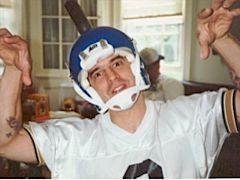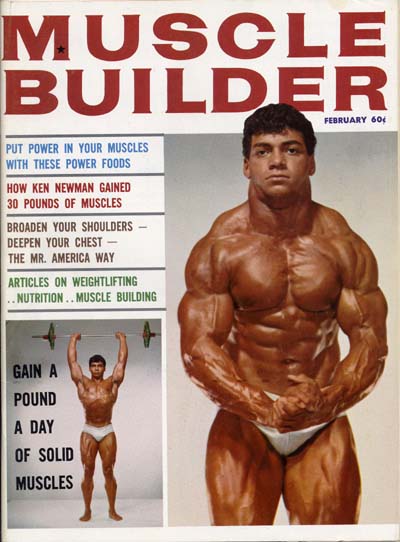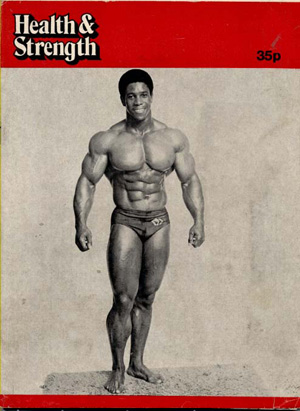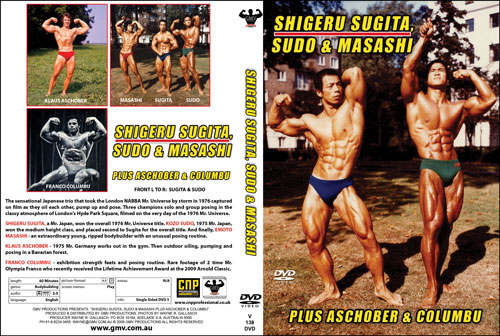Ken Leistner, neck helmet 1971.
Also by Jeff Everson:
Combining Football Training and Powerlifting (1982)
by Jeff Everson -
Head Strength Coach, University of Wisconsin
Because football is a sport of momentum, mass, static strength and explosive power, it is important that the training methods used to develop those physical parameters be closely matched from a physiological standpoint. Certainly, powerlifting is an activity that closely approximates the physical demands of football; in other words, a base of muscular and cardiovascular endurance, with requirements of very intense, short bursts of highly explosive muscular effort. Additionally, in case of line play, there are somewhat sustained strength moves; if you will, almost a sustained isometric effort, such as grinding out a heavy squat.
Olympic lifting would also appear to give good physiological carry-over, in terms of explosive power, or short bursts of muscular effort. While this is true, the ballistics and skills of parts of Olympic lifting are not wanted, such as in the squat clean and snatch moves. Moreover, the power clean and jerk from stands or push press are moves that can be done to augment a football player's development.
Do not be swayed by the arguments that since powerlifting consists of heavy slow moves only red muscle fiber will be hypertrophied. This is a groundless assumption and has no scientific backing in the literature. White muscle fiber most surely will be hypertrophied since the intensity of heavy, unending effort dictates that the nervous innervation and metabolic use pattern favors white muscle fiber development. Thus powerlifting can only have favorable influences on speed and quick strength.
However, it should be pointed out that if football is your main game, powerlifting should exist as an adjunct to total conditioning. Equal time must be given to the development of total conditioning that includes flexibility, foot speed, lateral agility and muscular endurance. At Wisconsin I have found powerlifting to be successful on a 3 day per week routine supplemented with 3 days a week of specific plyometric and speed drills. Ray Moran, a very successful powerlifter and football player in his own right, is my assistant and he would probably readily agree. We both fee that athletes that combine football and powerlifting frequently overtrain themselves.
Olympic lifting would also appear to give good physiological carry-over, in terms of explosive power, or short bursts of muscular effort. While this is true, the ballistics and skills of parts of Olympic lifting are not wanted, such as in the squat clean and snatch moves. Moreover, the power clean and jerk from stands or push press are moves that can be done to augment a football player's development.
Do not be swayed by the arguments that since powerlifting consists of heavy slow moves only red muscle fiber will be hypertrophied. This is a groundless assumption and has no scientific backing in the literature. White muscle fiber most surely will be hypertrophied since the intensity of heavy, unending effort dictates that the nervous innervation and metabolic use pattern favors white muscle fiber development. Thus powerlifting can only have favorable influences on speed and quick strength.
However, it should be pointed out that if football is your main game, powerlifting should exist as an adjunct to total conditioning. Equal time must be given to the development of total conditioning that includes flexibility, foot speed, lateral agility and muscular endurance. At Wisconsin I have found powerlifting to be successful on a 3 day per week routine supplemented with 3 days a week of specific plyometric and speed drills. Ray Moran, a very successful powerlifter and football player in his own right, is my assistant and he would probably readily agree. We both fee that athletes that combine football and powerlifting frequently overtrain themselves.
Specific Powerlifting for Football Weight Training Routine
Based on a 3-Day Per Week Program
Monday
1) Bench Press -
15, 10 [warmups]
3 sets of 5, pause reps
1 x 7, t-g [touch and go]
1 x 10, t-g
1 x 15, t-g.
2) Olympic Jerk From Stands -
5 sets of 3, work up 25 lbs on each set.
3) Heavy Alternate Dumbbell Curls -
3 x 8-10.
Rest 5 minutes, stretch out.
4) Squat, Low Bar Position -
12, 6 [warmups]
4 x 6, 75-80% of 1 Rep Max
Supplementals:
45-Degree Leg Press, 3 x 6
Leg Extension, 2 x 12-15
Leg Curl, 2 x 12-15
Neck, 2 x 12-15
Abs, 3 x 12, weighted.
Wednesday
1) Regular Deadlift -
12, 8 [warmups]
1 x 6
4 x 4, 80% 1RM.
2) Lat Pulldown to Front -
5 x 6-8
3) Inclines -
4 x 6
4) Push Press from Stands -
3 x 5 after warmup
5) Leg Press -
3 x 12-15
6) Leg Extension -
2 x 10 to failure
7) Leg Curl -
2 x 10 to failure
8) Neck -
3 x 6-8 each direction.
Friday
1) Power Clean from Floor -
1 x 6 [warmup], 5 x 3
2) Squat, High Bar -
2 x 10, 5 x 5 [only 70%]
Rest 10 minutes
3) Bench Press -
15, 8 [warmups], 4 x 5 t-g [80%]
4) Triceps Pushdown -
4 x 12
5) Leg Curls Only -
3 x 6-8
6) Hyperextensions -
3 x 15-20
7) Abdominals on Progressive Incline -
4 x 20.
The routine is fairly self-explanatory. it should be progressive and proceeded and followed by 10 minutes of vigorous static stretching or partner PNF stretching.
http://www.healthline.com/health/fitness-exercise/pnf-stretching#Overview1
You will notice that the routine combines elements of strength, power and muscular endurance, just what is needed for the football athlete.
I mentioned earlier that powerlifting training should be an adjunct, primarily for strength, while special drills should be done to develop power, flexibility, lateral movement and overall explosiveness. By explosiveness and speed, I mean, specifically, the attributes of abilities to move laterally quickly, turn rapidly, accelerate and decelerate rapidly, as well as, moving straight ahead in a quick, controlled manner. Many of these qualities are innate neurologically, however, the neurological and muscular system can be trained. This is evidenced by the facilitation of skill techniques, the improvement through form running and the muscle enzyme changes seen upon biopsy.
All of these factors can be collectively referred to as the development of motor pathways. In addition to weight training, certain exercises and drill can help facilitate this development. The following section presents information from European research on explosiveness and several fast foot drills we use that are designed to maximize agility, explosiveness and speed.
It is no secret that the European countries, particularly the eastern bloc, have done much more research on the physical aspects of sport, such as speed, explosiveness and agility. There are certain exercises, when performed at the right growth period (adolescence) that can optimally increase explosiveness. Elaborate European tests on youths aged 14-19 have found that the best exercises are the shuttle sprint backwards, the vertical jump, the bicycle movement while lying on the back and forward hopping for distance.
A fifth exercise that is particularly fine for football players is the 40 yard dash starting from a lying position, prone arms outstretched over head. The shuttle sprint backwards is done where the athlete sprints 10 yards backwards, comes back backwards, then goes 20 yards backwards, returns backwards, goes 30 yards backwards, returns backwards, then finally sprints 40 yards backwards and returns backwards. after this, the athlete jumps vertically for height 10 times.
For the uninitiated, this places tremendous strain on the quadriceps muscles. After this the athlete takes a short rest and then performs the lying bicycle 10 times for 10 second periods. Each period has a 5 second rest period in between. Thinking SPEED here is critical. The athlete then stands and does bounds for distance - 10 in a row.
A good athlete may reach 70-80 feet after all of this. The 40 yard spring starting from a prone position from a prone position with arms outstretched is better from an overall standpoint where total muscle development is wanted (abdominals), sprint effect and reaction. It would be very beneficial to defensive units.
These exercises are not done all the time, but are used for training variety in the conditioning phase.
3 x 5 after warmup
5) Leg Press -
3 x 12-15
6) Leg Extension -
2 x 10 to failure
7) Leg Curl -
2 x 10 to failure
8) Neck -
3 x 6-8 each direction.
Friday
1) Power Clean from Floor -
1 x 6 [warmup], 5 x 3
2) Squat, High Bar -
2 x 10, 5 x 5 [only 70%]
Rest 10 minutes
3) Bench Press -
15, 8 [warmups], 4 x 5 t-g [80%]
4) Triceps Pushdown -
4 x 12
5) Leg Curls Only -
3 x 6-8
6) Hyperextensions -
3 x 15-20
7) Abdominals on Progressive Incline -
4 x 20.
The routine is fairly self-explanatory. it should be progressive and proceeded and followed by 10 minutes of vigorous static stretching or partner PNF stretching.
http://www.healthline.com/health/fitness-exercise/pnf-stretching#Overview1
You will notice that the routine combines elements of strength, power and muscular endurance, just what is needed for the football athlete.
I mentioned earlier that powerlifting training should be an adjunct, primarily for strength, while special drills should be done to develop power, flexibility, lateral movement and overall explosiveness. By explosiveness and speed, I mean, specifically, the attributes of abilities to move laterally quickly, turn rapidly, accelerate and decelerate rapidly, as well as, moving straight ahead in a quick, controlled manner. Many of these qualities are innate neurologically, however, the neurological and muscular system can be trained. This is evidenced by the facilitation of skill techniques, the improvement through form running and the muscle enzyme changes seen upon biopsy.
All of these factors can be collectively referred to as the development of motor pathways. In addition to weight training, certain exercises and drill can help facilitate this development. The following section presents information from European research on explosiveness and several fast foot drills we use that are designed to maximize agility, explosiveness and speed.
It is no secret that the European countries, particularly the eastern bloc, have done much more research on the physical aspects of sport, such as speed, explosiveness and agility. There are certain exercises, when performed at the right growth period (adolescence) that can optimally increase explosiveness. Elaborate European tests on youths aged 14-19 have found that the best exercises are the shuttle sprint backwards, the vertical jump, the bicycle movement while lying on the back and forward hopping for distance.
A fifth exercise that is particularly fine for football players is the 40 yard dash starting from a lying position, prone arms outstretched over head. The shuttle sprint backwards is done where the athlete sprints 10 yards backwards, comes back backwards, then goes 20 yards backwards, returns backwards, goes 30 yards backwards, returns backwards, then finally sprints 40 yards backwards and returns backwards. after this, the athlete jumps vertically for height 10 times.
For the uninitiated, this places tremendous strain on the quadriceps muscles. After this the athlete takes a short rest and then performs the lying bicycle 10 times for 10 second periods. Each period has a 5 second rest period in between. Thinking SPEED here is critical. The athlete then stands and does bounds for distance - 10 in a row.
A good athlete may reach 70-80 feet after all of this. The 40 yard spring starting from a prone position from a prone position with arms outstretched is better from an overall standpoint where total muscle development is wanted (abdominals), sprint effect and reaction. It would be very beneficial to defensive units.
These exercises are not done all the time, but are used for training variety in the conditioning phase.



























